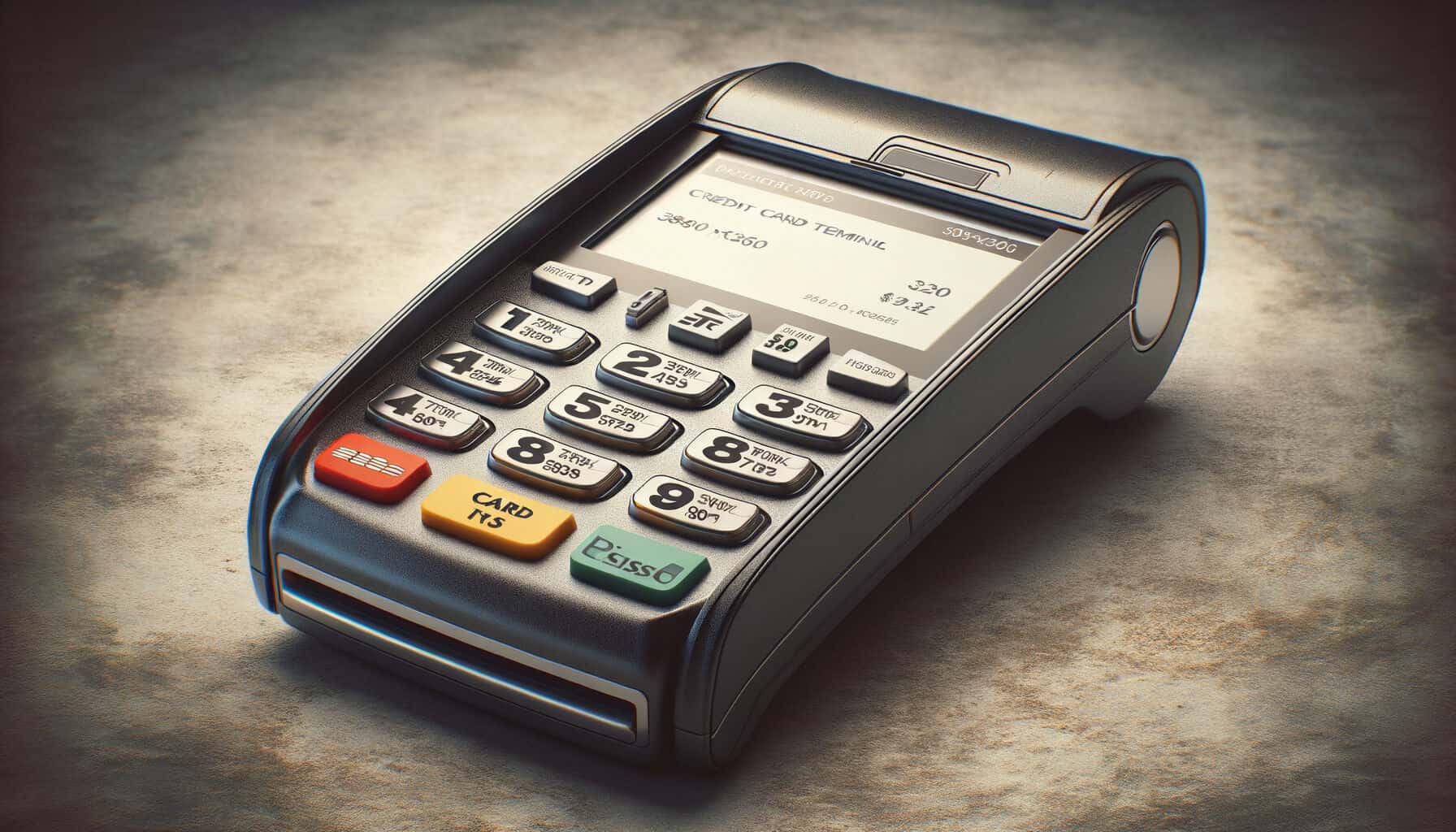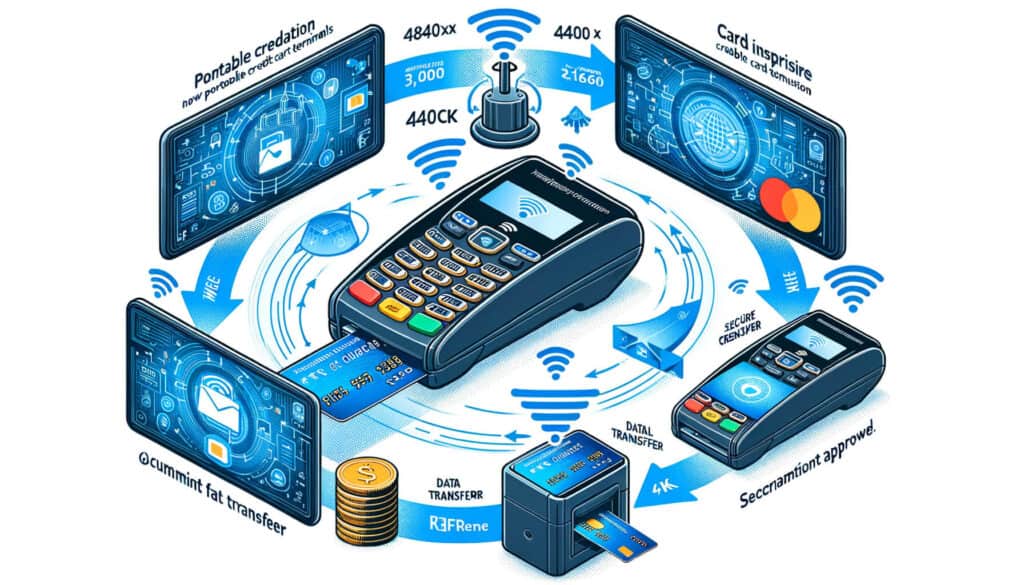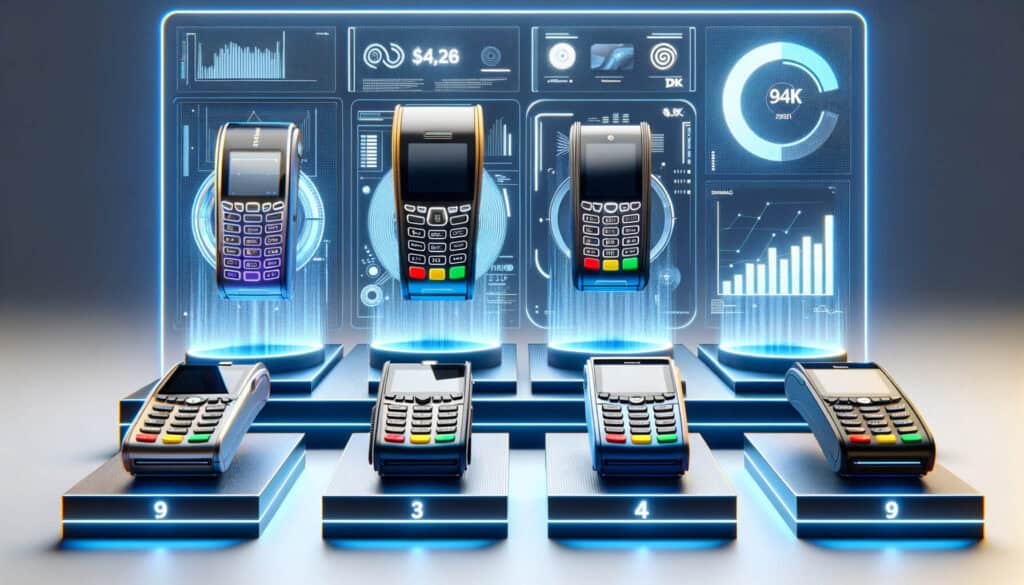
By Amanda Hoglund November 10, 2024
In today’s fast-paced world, convenience is key. Whether you’re a small business owner or a customer, the ability to make quick and secure payments is essential. This is where portable credit card terminals come into play. These innovative devices have revolutionized the way businesses accept payments, providing a seamless and efficient experience for both merchants and customers.
In this comprehensive guide, we will explore everything you need to know about portable credit card terminals, from how they work to the benefits they offer and the top brands in the market.
How Portable Credit Card Terminals Work: A Step-by-Step Guide

Portable credit card terminals are compact devices that allow businesses to accept credit and debit card payments on the go. They work by connecting wirelessly to a merchant account, enabling transactions to be processed in real-time. Here’s a step-by-step guide on how these terminals work:
- Merchant initiates a transaction: When a customer is ready to make a payment, the merchant enters the transaction details into the portable credit card terminal. This includes the purchase amount and any additional information required, such as the customer’s billing address.
- Customer inserts or swipes their card: The customer then inserts their card into the terminal’s card reader or swipes it through the magnetic stripe reader. Some modern terminals also support contactless payments, allowing customers to simply tap their card or mobile device on the terminal.
- Terminal communicates with the payment processor: Once the card is inserted or swiped, the terminal securely communicates with the payment processor to verify the card’s validity and the availability of funds. This is done through an encrypted connection to ensure the security of sensitive cardholder data.
- Customer enters a PIN or signs the receipt: Depending on the type of card and the payment method chosen, the customer may be required to enter their PIN or sign the receipt to authorize the transaction. This adds an extra layer of security to prevent unauthorized use of the card.
- Transaction is processed: Once the customer has completed the necessary steps, the terminal sends the transaction details to the payment processor for authorization. The processor then communicates with the customer’s bank to verify the transaction and deduct the purchase amount from the customer’s account.
- Receipt is generated: After the transaction is approved, the terminal prints or sends a digital receipt to the customer. This provides proof of payment and allows the customer to keep a record of their purchase.
Benefits of Using Portable Credit Card Terminals for Businesses

The adoption of portable credit card terminals has numerous benefits for businesses of all sizes. Here are some of the key advantages:
- Increased sales opportunities: By accepting credit and debit card payments, businesses can cater to a wider range of customers who prefer not to carry cash. This can lead to increased sales and revenue, especially in today’s cashless society.
- Improved customer experience: Portable credit card terminals offer a convenient and seamless payment experience for customers. They eliminate the need for customers to carry cash or visit an ATM, making the checkout process faster and more efficient.
- Mobility and flexibility: Unlike traditional point-of-sale systems, portable credit card terminals allow businesses to accept payments anywhere, whether it’s at a trade show, a pop-up shop, or a customer’s doorstep. This flexibility enables businesses to expand their reach and serve customers in various locations.
- Enhanced security: Portable credit card terminals employ advanced encryption and security measures to protect sensitive cardholder data. This reduces the risk of fraud and ensures that customer information is kept safe during the payment process.
- Streamlined accounting and reporting: Portable credit card terminals integrate with accounting software, making it easier for businesses to track and reconcile transactions. This eliminates the need for manual data entry and reduces the chances of errors in financial records.
- Faster access to funds: With portable credit card terminals, businesses can receive funds from credit and debit card transactions more quickly compared to traditional methods like checks. This improves cash flow and allows businesses to reinvest in their operations or meet financial obligations promptly.
Factors to Consider When Choosing a Portable Credit Card Terminal

When selecting a portable credit card terminal for your business, it’s important to consider several factors to ensure you choose the right device that meets your specific needs. Here are some key factors to consider:
- Connectivity options: Portable credit card terminals typically offer different connectivity options, such as Bluetooth, Wi-Fi, or cellular. Consider the availability and reliability of these connectivity options in your business environment to ensure seamless transaction processing.
- Compatibility with payment processors: Ensure that the portable credit card terminal you choose is compatible with the payment processor you plan to use. Not all terminals work with all processors, so it’s crucial to check compatibility before making a purchase.
- Security features: Look for terminals that offer robust security features, such as encryption and tokenization, to protect sensitive cardholder data. Additionally, consider terminals that are compliant with industry standards, such as the Payment Card Industry Data Security Standard (PCI DSS).
- Battery life and charging options: Since portable credit card terminals are designed for on-the-go use, it’s important to consider the battery life and charging options. Look for terminals with long battery life and convenient charging methods, such as USB or wireless charging.
- User-friendly interface: A user-friendly interface is essential for smooth and efficient transactions. Consider terminals with intuitive menus, easy-to-read screens, and responsive touchscreens to ensure a positive user experience for both merchants and customers.
- Cost and pricing structure: Evaluate the upfront cost of the terminal, as well as any ongoing fees or transaction charges associated with its use. Compare pricing structures from different providers to find the most cost-effective solution for your business.
Top Portable Credit Card Terminal Brands in the Market

When it comes to portable credit card terminals, several brands have established themselves as leaders in the market. These brands offer reliable and feature-rich devices that cater to the diverse needs of businesses. Here are some of the top portable credit card terminal brands:
- Verifone: Verifone is a well-known brand in the payment processing industry, offering a wide range of portable credit card terminals. Their devices are known for their durability, security features, and compatibility with various payment processors.
- Ingenico: Ingenico is another leading brand that specializes in payment solutions, including portable credit card terminals. Their devices are known for their sleek design, advanced security features, and user-friendly interfaces.
- PAX Technology: PAX Technology is a global provider of electronic payment solutions, offering a range of portable credit card terminals. Their devices are known for their reliability, affordability, and compatibility with multiple payment processors.
- Clover: Clover is a popular brand that offers a comprehensive suite of payment solutions, including portable credit card terminals. Their devices are known for their versatility, customization options, and seamless integration with other Clover products.
- Square: Square is a well-known brand that offers a range of payment solutions, including portable credit card terminals. Their devices are known for their simplicity, affordability, and user-friendly interfaces.
Setting Up and Activating Your Portable Credit Card Terminal
Once you have chosen a portable credit card terminal that meets your business needs, the next step is to set it up and activate it. Here’s a step-by-step guide to help you get started:
- Unbox the terminal: Carefully unbox the portable credit card terminal and ensure that all the necessary components are included. This typically includes the terminal itself, charging cables, and any additional accessories.
- Charge the battery: Before using the terminal, make sure to charge the battery fully. Follow the manufacturer’s instructions for charging, as different terminals may have different charging methods.
- Connect to a power source: Once the battery is charged, connect the terminal to a power source using the provided charging cable. This will ensure that the terminal remains powered during the setup process.
- Connect to a network: Depending on the connectivity options of your terminal, connect it to a network. This can be done through Wi-Fi, Bluetooth, or cellular data, depending on the available options and your business requirements.
- Install any necessary software: Some portable credit card terminals may require you to install specific software or applications to enable transaction processing. Follow the manufacturer’s instructions to install any necessary software on the terminal.
- Configure the terminal settings: Once the terminal is connected and any required software is installed, configure the terminal settings according to your business requirements. This may include setting the language, currency, tax rates, and other relevant settings.
- Test the terminal: Before accepting actual payments, it’s important to test the terminal to ensure that it is functioning correctly. Perform a test transaction using a test card or a dummy transaction to verify that the terminal can process payments successfully.
- Activate the terminal with your payment processor: Once the terminal is set up and tested, contact your payment processor to activate the terminal. They will provide you with the necessary information and credentials to link the terminal to your merchant account.
- Train your staff: If you have employees who will be using the portable credit card terminal, provide them with training on how to operate the device. This will ensure that they are familiar with the terminal’s features and can assist customers effectively.
Ensuring Security and Fraud Prevention with Portable Credit Card Terminals
Security is a top priority when it comes to portable credit card terminals. These devices handle sensitive cardholder data, and any breach can have severe consequences for both businesses and customers. Here are some measures you can take to ensure security and prevent fraud when using portable credit card terminals:
- Choose terminals with advanced security features: Look for terminals that offer encryption and tokenization to protect cardholder data during transmission and storage. Additionally, consider terminals that are compliant with industry standards, such as the Payment Card Industry Data Security Standard (PCI DSS).
- Use secure networks: When connecting your portable credit card terminal to a network, ensure that the network is secure. Avoid using public Wi-Fi networks, as they can be vulnerable to hacking and data breaches. Instead, use secure Wi-Fi networks or cellular data connections.
- Train your staff on security best practices: Educate your staff on security best practices, such as the importance of keeping passwords confidential and being vigilant for suspicious activity. Regularly remind them to follow security protocols and report any potential security breaches immediately.
- Monitor transactions and account activity: Regularly review transaction reports and account activity to identify any unusual or suspicious transactions. Set up alerts with your payment processor to notify you of any potentially fraudulent activity.
- Implement additional security measures: Consider implementing additional security measures, such as requiring customers to enter their PIN for all transactions or implementing two-factor authentication for online payments. These measures can add an extra layer of security and prevent unauthorized use of cards.
- Stay up to date with security updates: Keep your portable credit card terminal’s software and firmware up to date by installing security updates as soon as they become available. These updates often include patches for any identified vulnerabilities and help protect against emerging threats.
Troubleshooting Common Issues with Portable Credit Card Terminals
While portable credit card terminals are designed to be reliable and user-friendly, occasional issues may arise. Here are some common issues you may encounter with portable credit card terminals and how to troubleshoot them:
- Connectivity issues: If your terminal is having trouble connecting to a network, ensure that you are within range of a Wi-Fi signal or that your cellular data connection is strong. If the issue persists, try restarting the terminal or contacting your network provider for assistance.
- Battery life problems: If your terminal’s battery is draining quickly or not holding a charge, check for any background processes or applications that may be consuming excessive power. Close unnecessary applications and reduce the screen brightness to conserve battery life. If the issue persists, contact the manufacturer for further assistance.
- Card reading errors: If your terminal is having trouble reading cards, ensure that the card is inserted or swiped correctly. Clean the card reader with a soft cloth to remove any dirt or debris that may be obstructing the reading process. If the issue continues, try using a different card or contact the terminal manufacturer for support.
- Software glitches: If your terminal’s software is freezing or behaving erratically, try restarting the device. If the issue persists, check for any available software updates and install them. If the problem continues, contact the terminal manufacturer for further assistance.
- Printer issues: If your terminal’s printer is not working correctly, ensure that it has enough paper and that the paper is loaded correctly. Check for any paper jams or obstructions in the printer mechanism. If the issue persists, contact the terminal manufacturer for support.
- Error messages: If your terminal displays error messages, refer to the user manual or contact the terminal manufacturer for guidance. Error messages can indicate various issues, such as network connectivity problems, software conflicts, or hardware malfunctions.
Frequently Asked Questions (FAQs)
Q1. What is a portable credit card terminal?
A portable credit card terminal is a compact device that allows businesses to accept credit and debit card payments on the go. It connects wirelessly to a merchant account and enables real-time transaction processing.
Q2. How do portable credit card terminals work?
Portable credit card terminals work by securely communicating with a payment processor to verify the card’s validity and the availability of funds. They allow customers to insert or swipe their cards, enter a PIN or sign the receipt, and authorize the transaction. The terminal then sends the transaction details to the payment processor for approval.
Q3. What are the benefits of using portable credit card terminals for businesses?
Portable credit card terminals offer increased sales opportunities, improved customer experience, mobility and flexibility, enhanced security, streamlined accounting and reporting, and faster access to funds.
Q4. What factors should businesses consider when choosing a portable credit card terminal?
Businesses should consider factors such as connectivity options, compatibility with payment processors, security features, battery life and charging options, user-friendly interface, and cost and pricing structure when choosing a portable credit card terminal.
Q5. Which are the top portable credit card terminal brands in the market?
Some of the top portable credit card terminal brands in the market include Verifone, Ingenico, PAX Technology, Clover, and Square.
Q6. How do I set up and activate a portable credit card terminal?
To set up and activate a portable credit card terminal, unbox the device, charge the battery, connect to a power source and network, install any necessary software, configure the terminal settings, test the terminal, and activate it with your payment processor.
Conclusion
Portable credit card terminals have revolutionized payment processing for businesses, offering convenience, flexibility, and enhanced security. By understanding how these terminals work, the benefits they offer, and the factors to consider when choosing one, businesses can make informed decisions to improve their payment processing capabilities. With the right portable credit card terminal, businesses can streamline operations, increase sales opportunities, and provide a seamless payment experience for their customers.